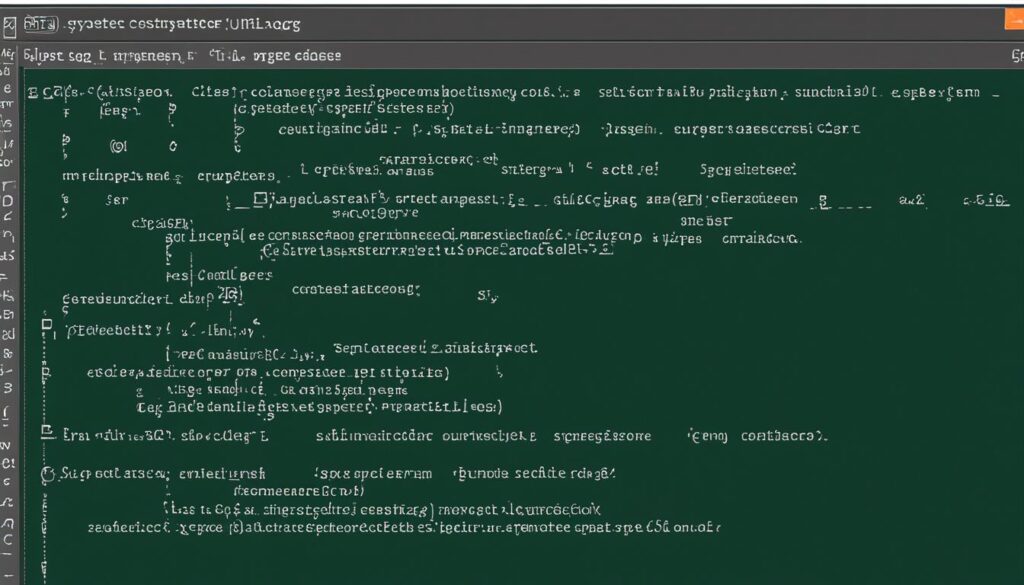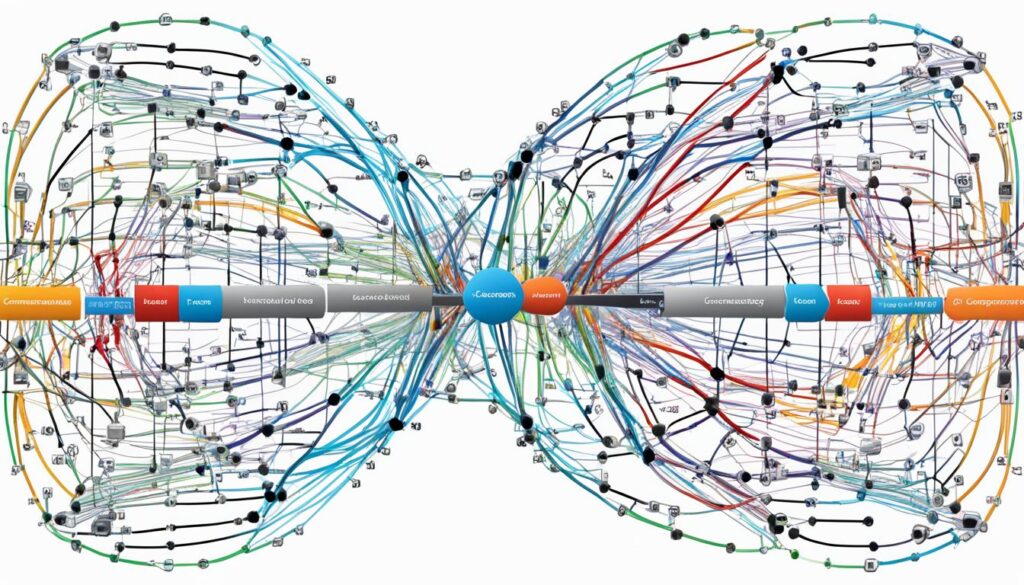Welcome to our article on design patterns in SystemVerilog. In this piece, we will delve into the world of design patterns in the context of SystemVerilog and explore their significance in the development of robust hardware designs. Design patterns provide a structured approach to HDL coding, enhancing efficiency and maintainability in the creation of complex hardware systems.
Table of Contents
Understanding SystemVerilog
Before we delve into the world of design patterns, it’s essential to have a strong understanding of SystemVerilog. SystemVerilog is a hardware description language (HDL) widely used in the design and verification of digital systems. It combines the features of Verilog HDL with additional constructs for efficient design modeling, simulation, and synthesis.
SystemVerilog offers a rich set of features that enable designers to express complex hardware behavior and to create reusable and scalable designs. Its syntax is similar to Verilog, making it easy for those familiar with Verilog to transition to SystemVerilog seamlessly.
One of the key advantages of SystemVerilog is its support for object-oriented programming (OOP) constructs, which allows designers to encapsulate hardware design blocks into reusable modules, packages, and classes. This level of abstraction enhances code modularity, readability, and reusability.
SystemVerilog also offers a range of built-in features and constructs that facilitate design verification, such as assertions, coverage, and dynamic arrays. These features help ensure the correctness and completeness of the hardware design, resulting in greater confidence in the final product.
Key Features of SystemVerilog:
- Support for design modeling and simulation
- Object-oriented programming constructs
- Improved code reusability and modularity
- Built-in design verification features
By mastering SystemVerilog and understanding its nuances, designers can unleash the full potential of this powerful HDL to create efficient, reliable, and scalable hardware designs.
Introduction to Design Patterns
In the field of HDL coding, design patterns play a crucial role in enhancing code reusability and maintainability. These patterns provide a structured approach to developing hardware designs using HDL languages like SystemVerilog. By incorporating design patterns into our coding practices, we can create more efficient and scalable designs.
Design patterns are proven solutions to common coding problems. They encapsulate best practices and techniques that have been refined over time by experienced hardware designers. By following these patterns, we can avoid reinventing the wheel and leverage the collective wisdom of the hardware design community.
Design patterns offer various benefits to HDL coders. They promote code reusability by providing reusable templates and frameworks for solving recurring design problems. This enables us to develop efficient designs with less effort and time. Additionally, design patterns enhance code maintainability by making our designs more modular and easy to understand. They provide clear and standardized structures that improve the readability and comprehensibility of the codebase.
One of the key advantages of using design patterns is their ability to simplify complex design problems. They offer proven solutions to intricate challenges, allowing us to focus on the business logic of our designs rather than getting bogged down by implementation details. By providing a common language and vocabulary for hardware designers, design patterns facilitate effective communication and collaboration among team members.
Throughout this article, we will explore various design patterns that are applicable in the context of HDL coding, particularly in SystemVerilog. We’ll delve into the different categories of design patterns and discuss their specific use cases in hardware design. We’ll also provide examples and implementation details to help you understand how to apply these patterns in your own projects.
Next, let’s take a closer look at the different types of design patterns that are commonly used in SystemVerilog.
Types of Design Patterns in SystemVerilog
When it comes to developing hardware designs in SystemVerilog, there are various design patterns that can be applied to enhance code structure, reusability, and maintainability. Understanding the different types of design patterns can greatly benefit designers in creating robust and efficient hardware designs. In this section, we will explore the various categories of design patterns in SystemVerilog and examine their specific use cases in hardware design.
Creational Design Patterns
In SystemVerilog, creational design patterns focus on object creation mechanisms. These patterns provide structured approaches to creating objects, allowing for flexibility and modifiability in a hardware design. The most commonly used creational design patterns in SystemVerilog include:
- Singleton Design Pattern
- Factory Method Design Pattern
- Abstract Factory Design Pattern
- Builder Design Pattern
- Prototype Design Pattern
Structural Design Patterns
Structural design patterns in SystemVerilog focus on the composition of classes and objects to form larger structures while maintaining flexibility. These patterns help in designing complex hardware systems by providing mechanisms to handle relationships between objects. Some commonly used structural design patterns in SystemVerilog include:
- Adapter Design Pattern
- Bridge Design Pattern
- Composite Design Pattern
- Decorator Design Pattern
- Facade Design Pattern
- Flyweight Design Pattern
- Proxy Design Pattern
Behavioral Design Patterns
Behavioral design patterns in SystemVerilog focus on the interaction between classes and objects, defining the communication patterns and responsibilities. These patterns enable designers to create flexible and maintainable hardware designs by providing mechanisms to manage complex behaviors. Some commonly used behavioral design patterns in SystemVerilog include:
- Observer Design Pattern
- Strategy Design Pattern
- Command Design Pattern
- Visitor Design Pattern
- State Design Pattern
- Template Method Design Pattern
By understanding the various types of design patterns in SystemVerilog and their implementations, designers can significantly improve the efficiency, maintainability, and reusability of their hardware designs. In the upcoming sections, we will delve deeper into specific design patterns, exploring their purpose, advantages, and how they can be effectively utilized in HDL coding.
| Design Pattern Category | Design Patterns |
|---|---|
| Creational | Singleton, Factory Method, Abstract Factory, Builder, Prototype |
| Structural | Adapter, Bridge, Composite, Decorator, Facade, Flyweight, Proxy |
| Behavioral | Observer, Strategy, Command, Visitor, State, Template Method |
Singleton Design Pattern in SystemVerilog
In SystemVerilog, the Singleton design pattern is a popular and widely used creational design pattern. It ensures that a class has only one instance and provides a global point of access to it. The Singleton design pattern is particularly useful when there is a need for a single instance of an object that can be accessed from anywhere in the codebase. It is often employed in scenarios where a shared resource needs to be managed centrally.
The purpose of implementing the Singleton design pattern is to control object creation, limiting it to just one instance, and providing a way to access that instance globally. This can be advantageous in situations where multiple instances of a class are unnecessary or even undesirable.
One of the primary advantages of using the Singleton design pattern in SystemVerilog is that it helps in reducing resource consumption. Since there is only one instance of the class, the memory and other resources required for object creation are minimized, resulting in more efficient and optimized code.
Another advantage of the Singleton design pattern is its easy accessibility and global availability. Once the Singleton instance is created, it can be accessed from any part of the codebase, making it convenient to use and share data among different modules.
The Singleton design pattern can be effectively utilized in HDL coding to manage shared resources, such as global configurations, memory blocks, or communication interfaces. It ensures that these resources are accessible in a controlled and centralized manner, eliminating the need for unnecessary object creation and duplication.
Implementation of Singleton Design Pattern in SystemVerilog
Implementing the Singleton design pattern in SystemVerilog involves creating a class with a private constructor and a static method to access the single instance of the class. The class should also have a static member variable to hold the instance.
Here’s an example of how the Singleton design pattern can be implemented in SystemVerilog:
“`
class SingletonClass;
// Private instance of the class
static SingletonClass instance;
// Private constructor
private function new();
endfunction
// Method to get the Singleton instance
static function SingletonClass getInstance();
if (instance == null)
instance = new();
end
return instance;
endfunction
endclass
“`
By calling the static method `getInstance()` of the `SingletonClass`, the single instance of the class can be accessed and shared throughout the codebase.
Using the Singleton design pattern in SystemVerilog can enhance code organization and improve the overall efficiency of your hardware designs. By ensuring only one instance of a class and providing a global point of access, the Singleton design pattern promotes code reusability, reduces resource consumption, and simplifies the management of shared resources.

Factory Method Design Pattern in SystemVerilog
In SystemVerilog, the Factory Method design pattern plays a significant role in creating objects with a common interface. It provides a flexible approach to object creation, allowing for easier maintenance and scalability in hardware designs.
The Factory Method design pattern focuses on encapsulating the object creation process within a separate factory class. This class is responsible for instantiating and returning objects of different types that adhere to a common interface. By employing this pattern, developers can decouple the object creation logic from the client code, resulting in a more modular and maintainable design.
The primary advantage of using the Factory Method design pattern is that it promotes code reusability. When new object types need to be added to the system, developers can simply introduce a new concrete factory class that implements the factory interface. This way, existing code remains unaffected, and the system can be easily extended to accommodate new object variations.
Furthermore, the Factory Method design pattern enhances flexibility by allowing clients to work with objects at a high level of abstraction. The client code only needs to interact with the factory class to obtain the desired objects, without worrying about the specific implementation details. This abstraction simplifies the usage of objects and enables code flexibility, making it easier to adapt and modify the system as requirements change.
Let’s illustrate the Factory Method design pattern in SystemVerilog with an example:
Example: Factory Method in SystemVerilog
We have a hardware design project that involves the creation of different types of memory modules. Each memory module must conform to a common interface to ensure compatibility within the system. Instead of creating memory modules directly in the client code, we can utilize the Factory Method design pattern to centralize their creation.
Here’s how the implementation could look:
| Memory Type | Factory Class |
|---|---|
| RAM | RamFactory |
| ROM | RomFactory |
| Cache | CacheFactory |
In the above table, we have different memory types, each associated with a specific factory class. The factory classes implement a common interface, providing a method to create the corresponding memory module.
The client code can then utilize the factory classes to create the required memory modules without directly instantiating them. This way, the object creation process is abstracted and can be easily modified or extended in the future.
In summary, the Factory Method design pattern in SystemVerilog offers a structured approach to object creation. It enhances code reusability, promotes flexibility, and simplifies the usage of objects by encapsulating the creation process within a factory class.
Observer Design Pattern in SystemVerilog
In SystemVerilog, the Observer design pattern plays a crucial role in facilitating communication between modules in a hardware design. It provides an efficient mechanism to ensure that changes in one module are immediately reflected in other modules that depend on it.
The Observer Design Pattern follows a publish-subscribe model, where there is a one-to-many relationship between the subjects (or publishers) and observers (or subscribers). The subject is responsible for maintaining a list of observers and notifying them when a change occurs.
By implementing the Observer Design Pattern, SystemVerilog designers can decouple modules, allowing them to operate independently while ensuring seamless communication. This promotes modularity, reusability, and flexibility in hardware designs, enabling easier maintenance and modification.
Let’s consider an example to better understand the Observer Design Pattern in action. Suppose we have a hardware system that consists of a main controller and multiple peripheral modules. Whenever the main controller’s state changes, all the peripheral modules need to be notified to perform specific actions based on the new state.

Using the Observer Design Pattern, the main controller can act as the subject, and the peripheral modules as the observers. Whenever the state of the main controller changes, it can notify all the registered peripheral modules about the update. This enables the peripheral modules to react accordingly and maintain synchronization with the main controller.
By leveraging the Observer Design Pattern, SystemVerilog designers can create modular, scalable, and maintainable hardware systems. It enhances the flexibility of inter-module communication and reduces tight coupling, making it easier to add or remove modules without disrupting the overall functionality of the system.
Conclusion
In conclusion, design patterns in SystemVerilog offer valuable techniques to improve HDL coding efficiency and maintainability. By leveraging these patterns, designers can create robust and scalable hardware designs.
Design patterns provide a structured approach to HDL coding, enhancing productivity and reducing the potential for errors. They offer reusable solutions to common design problems, allowing developers to save time and effort by implementing proven solutions rather than reinventing the wheel.
As an HDL developer, it is essential to keep exploring design patterns and incorporating them into your SystemVerilog projects. By doing so, you can further enhance your skills and stay up-to-date with the latest industry practices.

